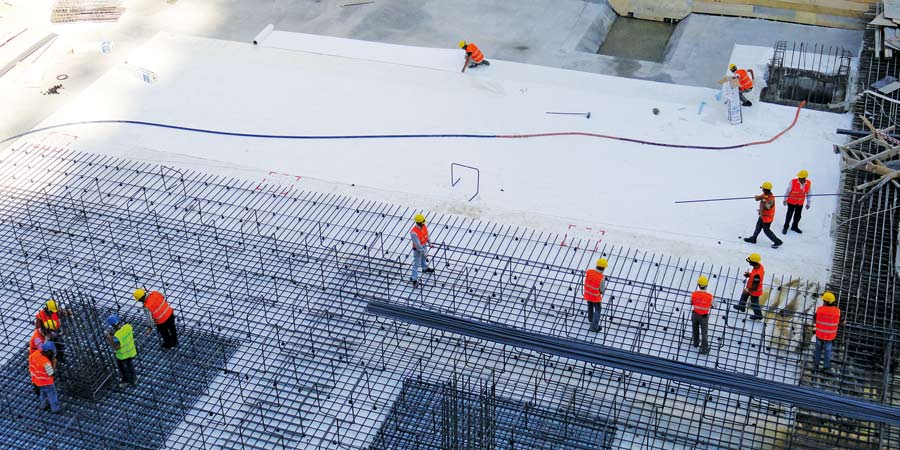Pre-applied Waterproofing: Understanding concrete bonding methods

Pre-applied waterproofing is used below basement slabs and behind walls on job sites where there is limited space for excavation and heavy equipment. Instead of pouring the foundation and then applying waterproofing to the outside of the foundation wall, pre-applied waterproofing is placed before the foundation is poured. The slab and wall concrete is then cast on top of the membrane.
A bonded pre-applied waterproofing membrane (also called a blindside membrane) must seal tightly to the concrete in order to prevent lateral water migration between the membrane and the structural concrete. It has to be able to stay in place, even if the concrete cracks or the soil beneath it begins to settle.
Types of waterproofing bonding
There are two different ways that waterproofing membranes adhere to concrete:
A mechanical bond and an adhesive bond.
With a mechanical bond, the membrane typically has one side that has fleece or mesh on it. As the concrete hardens, the bristles of the fleece attach to the concrete. This provides a certain level of bonding so that the membrane cannot be detached. However, the bond does not necessarily form an intimate watertight seal. Like the bristle of a brush, the bristles have gaps and this creates capillaries for water to migrate through.
With a pressure sensitive adhesive bond, there is an intimate and continuous adhesion that aggressively seals the concrete and the membrane together.
Shortcomings of mechanically bonded waterproofing membranes
With a membrane that uses mechanical bonding, it has been demonstrated that even if the membrane is firmly attached to the concrete, water can still track between the membrane and the concrete in all directions, in search of cracks or other weaknesses. Leaks can be sealed from the inside, but the water will keep tracking under pressure to find more ways into the structure. In general, adhesives used in such membranes serve only to attach the fleece to the carrier film and offer no additional waterproofing resistance.
Advantages of adhesive bonding
A fully bonded adhesive membrane creates an integral seal between the concrete and the waterproofing membrane so that in the event of a breach in the membrane, water is prevented from passing the membrane and migrating. This means that water remains excluded, so that in the worst case of a breach coinciding with a crack or weakness in the concrete, leaks can be localized and fixed quickly, resulting in lower remedial measures or maintenance costs during the life of the structure.
How the PREPRUFE® pre-applied waterproofing membrane works
The PREPRUFE® pre-applied waterproofing membrane is a fully bonded adhesive membrane. The bond is continuous below the slab and behind the walls, to form a fully sealed structure. This seal prevents the lateral migration of water into and around the structure. If a breach occurs, the membrane ensures that water under hydrostatic pressure is unable to migrate between the membrane and the concrete, limiting the risk of waterproofing failure. Independent testing shows the PREPRUFE® waterproofing membrane can resist lateral water migration at pressures in excess of 70 meters head of water.
Learn more about PREPRUFE® Plus waterproofing membrane
Tags
- PREPRUFE® Plus
- Waterproofing